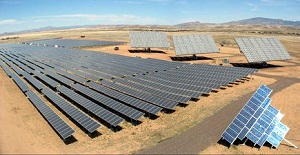SEIA, solar industry insiders discuss diversifying the solar industry
 The Solar Energy Industry Association (SEIA) and solar energy insiders discussed the diverse forms of solar that are taking root in the U.S. and across the world during a May 24 teleconference.
The Solar Energy Industry Association (SEIA) and solar energy insiders discussed the diverse forms of solar that are taking root in the U.S. and across the world during a May 24 teleconference.
The panelists included SEIA CEO Rhone Resch, Vice President of Resource Planning at Arizona Public Service (APS) Pat Dinkel, Senior Vice President of Development at SolarReserve Tom Georgis, and Vice President of Government Affairs at SCHOTT North America Jim Stein.
Each spoke from a standpoint of dealing with both concentrating solar power (CSP) and photovoltaics (PV) projects on the utility-scale and the challenges that they face when pursuing such projects.
Always a hotbed issue is the plight of federal incentive programs that have supported development of large-scale projects.
SolarReserve’s 110-megawatt Crescent Dunes Solar Energy Project in Nevada, for instance, won a $737 million conditional loan guarantee from the Department of Energy last week. The guarantee will help it attract other, lower-cost financing.
SolarReserve develops utility-scale solar projects with molten salt thermal storage, like at Crescent Dunes, and photovoltaics.
“As a developer we took a look at market conditions. We certainly took a look at the prices in the market and made a strategic decision to diversify and expand our development portfolio to include PV projects,” Georgis said.
The company can only do CSP where there’s a high solar resource, like in the southwest, Georgis said.
“PV certainly affords us the ability to expand beyond the American southwest, and we’re currently doing so,” he said. The company concluded that there’s a vast global opportunity, Georgis said.
APS is incorporating a vast variety of solar and associated technologies, from CSP solar thermal arrays, to distributed generation and battery storage, to thin-film and silicon photovoltaics.
“This is a topic that APS has been very focused on,” Dinkel said. “It’s a very vibrant and evolving marketplace, and diversification is very important to that.”
The utility has contracted with Abengoa Solar for all 250 megawatts of power that will be produced at the Solana solar plant outside of Gila Bend, Ariz. APS also contracted with Solon for a silicon solar farm on trackers and First Solar for a fixed thin-film solar farm, each 17-megawatt facility is being built near Gila Bend.
“Both projects expect to be online late this year,” Dinkel said. Gila Bend streamlined the permitting process, allowing the project developers to get city approval in six weeks rather than six months, he said.
Overall, the solution calls for a mix of all these technologies. SolarReserve’s power towers can serve as base-load generation, whereas photovoltaics can serve peak demand.
“We need a healthy mix of CSP with storage. What we’re seeing with a lot of PV coming onboard and certainly additional wind—there are going to be intermittency challenges for the system operators,” Georgis said.
On the other hand, PV is cheaper now.
“It’s so much more economic right now to look at these smaller-scale PV projects of 10 to15 megawatts,” Dinkel said. “You can plot them around your system and get a pretty reasonable cost, and you don’t have worry about system integration. And you’re talking $50 to $100 million to finance. We think that’s pretty easy for utilities to do and finance. The most important part of that is making sure we’re aligned with our state regulators.”
Image courtesy of NREL.



